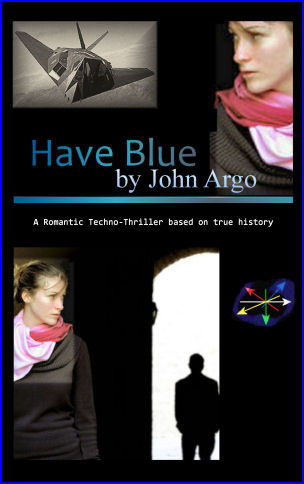Introductions
Prolog
 Have Blue was the most covert and critical U.S. military project since the top-secret atomic bomb project during World War II. In 1973, the fate of the world hung on what would eventually become known as the F117-A stealth fighter. This is a historical techno-thriller with a strong romantic story line, loosely based on the first days of that project. The hero, a young engineer with a fascination for aerodynamic nose cones, discovers a stunning mathematical secret in an obscure Soviet journal that even the Russians overlooked...and saves the world. Have Blue was the most covert and critical U.S. military project since the top-secret atomic bomb project during World War II. In 1973, the fate of the world hung on what would eventually become known as the F117-A stealth fighter. This is a historical techno-thriller with a strong romantic story line, loosely based on the first days of that project. The hero, a young engineer with a fascination for aerodynamic nose cones, discovers a stunning mathematical secret in an obscure Soviet journal that even the Russians overlooked...and saves the world.
San Diego, 1999
See also: Epilog
Dedication
This novel is dedicated to the staff at the Skunk Works who made the Stealth technology possible, especially Ben Rich and Denys Overholser. Your attention is directed to the nonfiction book Skunk Works : A Personal Memoir of My Years at Lockheed by Ben R. Rich with Leo Janos (Little Brown and Co., 1996) as an excellent source of entertaining and informative reading on the real story of how this technology came to be. You can also obtain an information packet, including attractive photos and booklets, by writing to Lockheed Skunk Works, Georgia. This is a classic tale that deserves to be retold, time and again, by different authors and in different ways, over generations to come. I have chosen to tell it as a fictionalized technothriller and a love story.
Preface
This book is fiction, based on astonishing fact. The love story is an invention, as are all the main characters and the Burbank suburb of Madeira. The background is real history—about how an obscure mathematician changed history and probably saved the world.
The most secret military project in U.S. history, after the Manhattan Project, was one called Have Blue.
As a result of the October 1973 Yom Kippur War, American strategic planners were horrified to realize that the world had nudged several steps closer to total annihilation.
On October 6, 1973, Egypt and Syria launched a sudden and massive attack from the north and the south, designed to destroy the Jewish state. The Arabs were supplied and trained by the Soviet Union, while the Israelis were being supported by the United States and several European powers. The Yom Kippur War represented a test of the superpowers' relative strengths and weaknesses.
Israel managed to halt the onslaught and turn the tables on the field of battle, routing her attackers. However, the Israeli Air Force lost 109 aircraft in 18 days of fighting. It seemed the Soviet Union had supplied their allies with invincible radar systems. American strategists analyzing these data came to the sobering conclusion that, if World War III were to begin, the United States Air Force would be shot out of the skies within as few as 17 days by the radar-based defenses of the Soviet Union.
Was radar invincible?
If so, the next conclusion would be truly horrifying.
The United States was locked in a deadly embrace with the Soviet Union called MAD—Mutually Assured Destruction. Together, the two powers possessed about 50,000 nuclear warheads—enough to destroy much of life on earth. If either side launched first, the other side would retaliate in kind.
The safety of the world—the survival of mankind—depended on the standoff between the two superpowers in which both sides were frozen and unable to act. The Yom Kippur War punched a hole in this concept big enough to drive a world war through.
The United States rested its strategic plan on a three legged stool: long-range bombers, nuclear subs armed with missiles, and Intercontinental Ballistic Missiles (ICBMs). Of these three, only the bombers had the flexibility to carry either conventional or nuclear bombs.
If our bombers could no longer penetrate Soviet radars, then the first and oldest leg of our strategic plan was gone, and the stool must surely fall. The only two options left would be nuclear ones, in the form of our subs and ICBMs—the so-called nuclear "Doomsday Card."
An urgent call—and an extremely secret one—went out to the major aerospace firms. At the President's request, an all-out effort must be made to develop some kind of weapon—a coating perhaps?—that would make our bombers invisible to radar. So far, no effective deterrent existed. The major contractors submitted their bids and the deadline passed.
At the last moment, the project director at one of our most secret research and development facilities realized they'd been overlooked—because they were so secret that the top people in defense didn't even know about them. This was Lockheed's Skunk Works, which over the years has produced some of our most esoteric—and secret—aircraft, like the U-2 spy plane, the D-21 drone to overfly Red China, and the SR-71 Nighthawk that could cross the U.S. in less than an hour.
But the Skunk Works hadn't built an Air Force plane since the Korean War. The Skunk Works's biggest customer was the CIA—which, in a surprising turn of strategy, let Lockheed tell the top Air Force brass about the Skunk Works.
At that moment in history, a young mathematician, outdoorsman, and jet nose cone expert at the Skunk Works stumbled upon an arcane Soviet paper that contained the key to beating radar.
It's called Stealth, and the F-117A Stealth fighter (really a small bomber capable of dropping two "smart" bombs) made its debut in the Gulf War in 1991. The Stealth plane flew only two percent of the air missions but knocked out about 40% of the total targets during the war. The Stealth fighters did almost all the bombing raids in and around Baghdad, precisely placing their bombs—including the one that went right down the air shaft of the Iraqi Air Force ministry and knocked the Iraqi Air Force out of the sky within the first few minutes of the war.
The F117-A Stealth fighter is one of history's great success stories.
This novel is a fiction based on the wondrous discovery made by a young man engaged in highly secret research. In this story, which is a story, the fictional hero based on that true-life mathematician discovers something else—the beautiful widow next door, and her young son who loves model airplanes.



|

 Thank you for reading. If you love it, tell your friends. Please post a favorable review at Amazon, Good Reads, and other online resources. If you want to thank the author, you may also buy a copy for the low price of a cup of coffee. It's called Read-a-Latte: similar (or lower) price as a latte at your favorite coffeeshop, but the book lasts forever while the beverage is quickly gone. Thank you (JTC).
Thank you for reading. If you love it, tell your friends. Please post a favorable review at Amazon, Good Reads, and other online resources. If you want to thank the author, you may also buy a copy for the low price of a cup of coffee. It's called Read-a-Latte: similar (or lower) price as a latte at your favorite coffeeshop, but the book lasts forever while the beverage is quickly gone. Thank you (JTC).
|
TOP
|
MAIN
Copyright © 1996 by John Argo, Clocktower Books. All Rights Reserved.
|